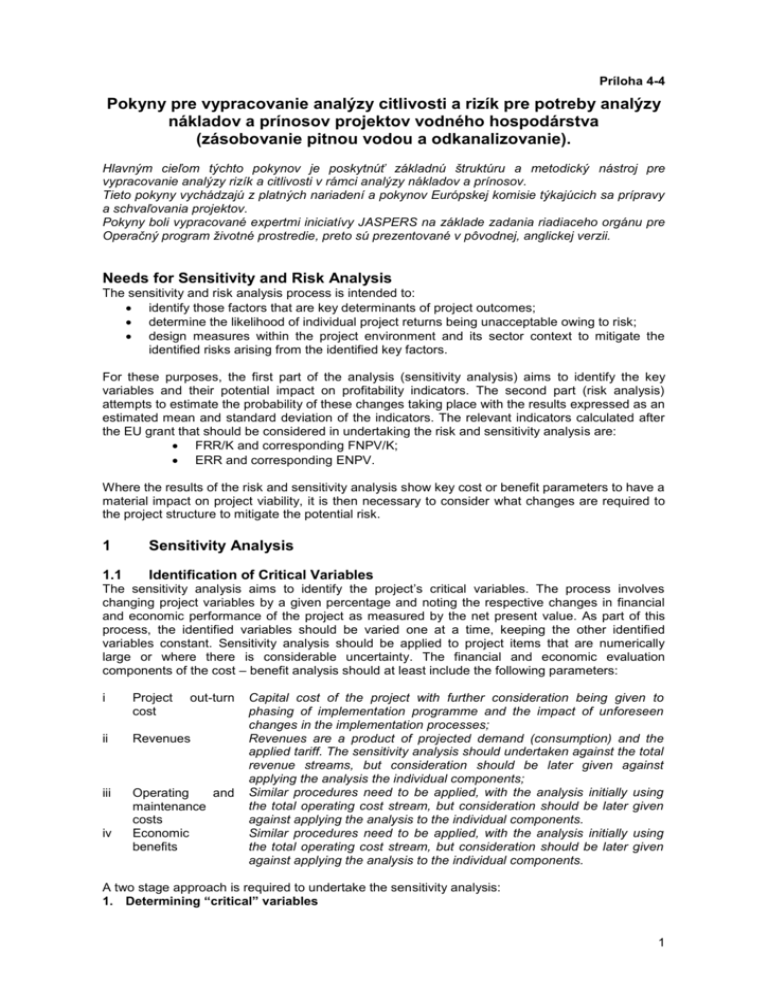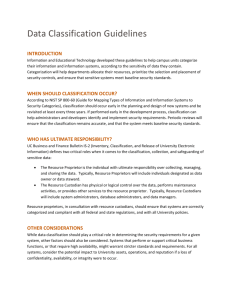GUIDELINES FOR DEMAND ANALYSIS IN THE COST
advertisement

Príloha 4-4 Pokyny pre vypracovanie analýzy citlivosti a rizík pre potreby analýzy nákladov a prínosov projektov vodného hospodárstva (zásobovanie pitnou vodou a odkanalizovanie). Hlavným cieľom týchto pokynov je poskytnúť základnú štruktúru a metodický nástroj pre vypracovanie analýzy rizík a citlivosti v rámci analýzy nákladov a prínosov. Tieto pokyny vychádzajú z platných nariadení a pokynov Európskej komisie týkajúcich sa prípravy a schvaľovania projektov. Pokyny boli vypracované expertmi iniciatívy JASPERS na základe zadania riadiaceho orgánu pre Operačný program životné prostredie, preto sú prezentované v pôvodnej, anglickej verzii. Needs for Sensitivity and Risk Analysis The sensitivity and risk analysis process is intended to: identify those factors that are key determinants of project outcomes; determine the likelihood of individual project returns being unacceptable owing to risk; design measures within the project environment and its sector context to mitigate the identified risks arising from the identified key factors. For these purposes, the first part of the analysis (sensitivity analysis) aims to identify the key variables and their potential impact on profitability indicators. The second part (risk analysis) attempts to estimate the probability of these changes taking place with the results expressed as an estimated mean and standard deviation of the indicators. The relevant indicators calculated after the EU grant that should be considered in undertaking the risk and sensitivity analysis are: FRR/K and corresponding FNPV/K; ERR and corresponding ENPV. Where the results of the risk and sensitivity analysis show key cost or benefit parameters to have a material impact on project viability, it is then necessary to consider what changes are required to the project structure to mitigate the potential risk. 1 Sensitivity Analysis 1.1 Identification of Critical Variables The sensitivity analysis aims to identify the project’s critical variables. The process involves changing project variables by a given percentage and noting the respective changes in financial and economic performance of the project as measured by the net present value. As part of this process, the identified variables should be varied one at a time, keeping the other identified variables constant. Sensitivity analysis should be applied to project items that are numerically large or where there is considerable uncertainty. The financial and economic evaluation components of the cost – benefit analysis should at least include the following parameters: i Project cost ii Revenues iii Operating and maintenance costs Economic benefits iv out-turn Capital cost of the project with further consideration being given to phasing of implementation programme and the impact of unforeseen changes in the implementation processes; Revenues are a product of projected demand (consumption) and the applied tariff. The sensitivity analysis should undertaken against the total revenue streams, but consideration should be later given against applying the analysis the individual components; Similar procedures need to be applied, with the analysis initially using the total operating cost stream, but consideration should be later given against applying the analysis to the individual components. Similar procedures need to be applied, with the analysis initially using the total operating cost stream, but consideration should be later given against applying the analysis to the individual components. A two stage approach is required to undertake the sensitivity analysis: 1. Determining “critical” variables 1 In accordance with EU Guidelines the process of identifying “critical” variables requires the calculation of the profitability indicators after variations of +/- 1% in the main cost and benefit streams. Guide suggests that “critical” variables are those where a 1% variation (positive or negative) changes the net present value (in either economic or financial terms) by more than 1%. It should be noted that Guidelines only suggest the above methodology as a basis for identifying “critical” variable and the methods to be actually applied can be at the discretion of the applicant. The variations should be applied annually on the base case scenario. Within this process, it is recommended that consideration should be given to reducing the net present value suggested threshold (or increasing the variation) to ensure that a comprehensive sensitivity analysis is undertaken. 2. Presentation of the Sensitivity Analysis The results of the analysis should be presented as below. The table is abstracted from the Template of the Application form for a Major Project. A further column (% change in FNPV and ENPV) has been included to more easily identify “critical” variables. The extent to which the “critical” variables should be changed in presenting these results can be left to the discretion of the applicant. However, it is recommended that variations applied should be within acceptable boundaries and / or result in a material impact on the profitability indicator. Variable tested FRR/K FNPV /K % Change in FNPV/K ERR ENPV % Change in ENPV Base Case Increase of x% in project out-turn costs [1] Decrease of x% in project out-turn costs [1] Decrease of x% in revenues [2] Increase of x% in revenues [2] Decrease of x% in O&M costs [3] Increase of x% in O&M costs [3] Increase of x% in economic benefits Decrease of x% in economic benefits [1] Financial cost in the case of FRR/K and FNPV/K and economic cost in the case of ERR and ENPV. [2] Total revenues in the case incremental revenues. [3] For FRR/K and FNPV/K, total financial O&M cost in the case of incremental financial O&M cost. For ERR and ENPV, incremental economic O&M cost. Two points should be clearly stated: As project revenues are not an economic benefit – the sensitivity analysis should not be undertaken to examine the impact of changes in project revenue on the economic rate of return and economic net present value. Similarly, economic benefits are not financial revenue and hence the sensitivity analysis should not be undertaken to examine the impact of changes in economic benefits on the financial net present value. 1.2 Determining Switching Values of the Critical Variables The switching value is the percentage change in a variable for the NPV becomes zero or the IRR equals the opportunity cost of capital and hence the project decision to change. Switching value therefore determines the change in the identified critical variable at which point a decision concerning the viability of the project, under its initial configuration, should be implemented. Switching value analysis provides the background for undertaking the risk analysis. Switching value should be calculated as part of the project’s economic and financial analysis. It requires an iterative analysis to determine the required percentage change in a variable to change the projects’ net present value to zero. Change needs to be applied on an annual basis to the identified critical variable, with each critical variable being separately identified. Variables that need to be considered should include all identified “critical” variables and any sub components where the critical variable is made up of several parts. 2 Risk Analysis Risk analysis examines the probability with which the required change in a variable has a material impact on project viability. In the course of risk analysis, the following risks are examined: In the light of their influence on the financial and performance indicators, risks arising owing to variables that are deemed as critical; 2 Other risks. Above risks should be analysed in detail using a quantified approach. EU Guidance on the methodology for carrying out cost – benefit analysis does not specify the approach to take that largely depends on availability of data. However, Guidance recognises where there is a lack of historical data it might prove difficult to derive sensible assumptions on the critical variables’ probability distribution. In these instances a qualitative risk assessment is seen as sufficient. Notwithstanding this, Section E.3.3 of the application form for Major Project provides guidance for the overall requirements of risk analysis as: “Describe the probability distribution estimate of the project’s financial and economic performance indexes. Provide relevant statistical information (expected values, standard deviation)”. 2.1 Methods of Undertaking a Quantified Risk Analysis There are two options for the quantification of the level of certainty of the calculated values for the profitability indicators. The first method using Monte Carlo type analysis is a sophisticated tool that requires a very clear understanding of the project and analysis of data of existing situation and the with and without project scenarios. It should be mentioned that the results of the Monte Carlo can be misleading if either the quality of inputs (such as probability distributions for parameters) is insufficient or the assumptions used are not fully justified. The second method is less sophisticated and can be undertaken in circumstances where a probability distribution of the key variables is not known or can be reasonably accurately modelled. It is considered that the second method would be applicable for most projects in Slovakia. However, the first method should be promoted and at least retained as a target to be achieved. The procedures to undertake these methods of risk analysis are described below: a. If the probability distribution of the key variables 1 can be defined then the Monte Carlo method of risk analysis can be applied. Method consists of simultaneously assigning random values to all the key variables (within their expected distributions) for a number of repetitions to produce a probability distribution for each profitability indicator. For each profitability indicator the mean and standard deviation should be calculated. Monte Carlo analysis can be simulated using Microsoft Excel (as an add-in facility) or by using other packages such as @RISK, Crystal Ball and RiskEase. Results of the analysis that should be produced are summarised below: 1 Or at least a reasonable range of variation, assuming a normal distribution between the maximum and minimum value. 3 b. If probability distribution of the key variables can not be defined then the risk assessment should be carried out by defining an optimistic and a pessimistic scenario that includes all the key variables, and then calculating the two extreme values for the profitability indicators based on those two scenarios. A quantitative analysis should be undertaken wherever possible with optimistic and pessimistic scenarios developed on the basis of past experience and using when possible results of other projects that have been completed or are under implementation. Although, the Guidance on the methodology for carrying out cost benefit analysis – working document no.4 requires an assessment of the project’s performance indicators it is also important that the financial risk assessment should also be analysed from the perspective of the Operating Entity. Furthermore, while it is recognised that the Guidance note only requires the financial evaluation of a project, standard international practice is to undertake financial evaluation of the impact of the project on the Operating Entity. It is therefore strongly encouraged that the methodology for undertaking the financial evaluation in Slovakia is firstly extended to include and analysis of the full financial position of the Operating Entity and secondly a risk analysis is then undertaken on this basis. 2.2 Supplementary Need for a Qualitative Risk Assessment In addition to the quantitative risk assessment, certain risks can not be quantified and also may not have a direct impact on profitability indicators. A qualitative assessment of these risks needs to be undertaken. Risks that can not be easily quantified include: Political risk that could manifest itself in delays to implementation as well as agreement to introduce changes (such as tariff increases) that have a direct impact on sustainability; Changes in the regulatory regime; Financing risk arising from shortfalls or delays in funding from local contributions and external (international) sources; Social and environmental acceptability; Results of the qualitative risk assessment should be integrated with the findings of the quantitative risk assessment to develop a risk management strategy. Qualitative risk assessment should lead to the definition of proper actions to manage project risks. 4 2.3 Risk Management Strategy The results of the risk management analysis should be used to either re-define the project configuration or to put in place a risk management strategy to militate against the main identified risks. The main methods for the management of risk can include: Cancellation of the project or certain parts of the project; Increasing reserves for deadlines and costs; Transfer of risks including the use of guarantee obligation, insurances and sureties; Re-allocation of risks amongst the concerned parties on the basis of the ability of the concerned party to manage the level of risk. Specific complementary actions to cover political or institutional risk, etc. 5








